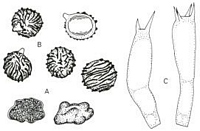|
 Zelleromyces striatus Zelleromyces striatus
SynonymsOctaviania striata
BiostatusAbsent from region
Images (click to enlarge)
Caption: A. habit and section x 1; B. spores x 1750; C. basidia x 1000. |
Article: Beaton, G.W.; Pegler, D.N.; Young, T.W.K. (1984). Gasteroid Basidiomycota of Victoria State, Australia. 2. Russulales. Kew Bulletin 39(4): 669–698.
Description: Gasterocarp 1.5-2.5 cm diam., irregularly globose or more usually ellipsoid with a depressed base around the point of attachment. Peridium greyish orange (M.4.5YR/7.5/5.5) when fresh, drying dull reddish brown, glabrous and smooth drying rugose. Gleba pale orange, drying ochraceous, labyrinthoid, of empty, ellipsoid or irregular chambers, variable, 2-4 per mm. Tramal plates 55-75 µm thick, with a broad hymenophoral trama and well developed sub-hymenial layers. Columella absent; sterile base present or absent. Laticiforous elements present, forming an extensive system both in the hymenophoral trama and in the lower layers of the peridiopellis, exuding latex when cut. Spores 7.5-10 x 7-8.5(9 ± 0-5 x 7.7 ± 0.5) µm, Q. = 1-16; subheterotropic, globose to broadly ovoid, hyaline or faintly tinted, thin-walled, with an ornamentation of continuous or interrupted ridges, 0.7-1.5 µm high, running parallel with each other to form a pattern of concentric striae, at times branching and anastomosing especially on the adaxial surface, strongly amyloid; suprahilar plage not differentiated; hilar appendix 1.5-1.8 x 0.7-1.5 µm, obconical. Basidia 35-45 x 7-10 µm, cylindrico-clavate, bearing 2 or 4 sterigmata. Cystidia absent. Hymenophoral trama regular, hyaline, of more or less parallel, thin-walled hyphae, 2-10 µm diam., plus an extensive system of branching laticiferous elements, 2-5-8 µm diam., with refractive contents. Subhymenial layer well developed, 19-30 µm broad, pseudoparenchymatous. Peridiopellis an epicutis, 60-90 µm thick, of densely woven, agglutinated hyphae, with a brown encrusting pigment, together with numerous laticiferous elements in the lower layers.
Distribution: VICTORIA. Eildon-Jamieson end of Warburton road, hypogeal in mixed eucalyptus forest, 21 April 1974, G. Beaton, Mallet Creek track near Eildon, 25 May 1974, G. Beaton, Jerusalem Creek near Eildon, 30 Aug. 1974, K. & G. Beaton, Otway Range, Grey Riv. Res., IS July 1982, K. & G. Beaton, Rubicon, Royston road, 16 May 1982, K. & G. Beaton 16; Kinglake Nat. Park, Bald Spur road, hypogeal under Eucalyptus radiata, 29 Aug. 1982, A. C. Beauglehole, Heath road, Mt Deception road junction, Lower Gleneig Nat. Park near Portland, hypogeal under E. obliqua, 12 Sept. 1982, Beauglehole.
Notes: The species was originally described from South Australia, and at the same time recorded from New South Wales (Cunningham 1935: 1 19; 1944: 61), and it is now known to be quite common in Victoria where it grows in small hypogeal clusters. The gasterocarp lacks a columella yet may sometimes develop a small, substipitate base, and very occasionally the gleba may become partially exposed around the base. The spores are not truly symmetric and statismosporic in structure but show some differentiation between an abaxial surface with an ornamentation of parallel ridges, and a smaller adaxial surface with a more irregular pattern of ornamentation. The hilar appendix is also in a slightly excentric position. This raises the possibility of the species being assigned to Russulaceae, rather than to Elasmomycetaceae, but owing to the absence of (a) a percurrent columella, (b) a differentiated suprahilar plage on the spore, and (c) sphaerocytes, the genus Zelleromyces is more appropriate, and the combination is proposed.
|